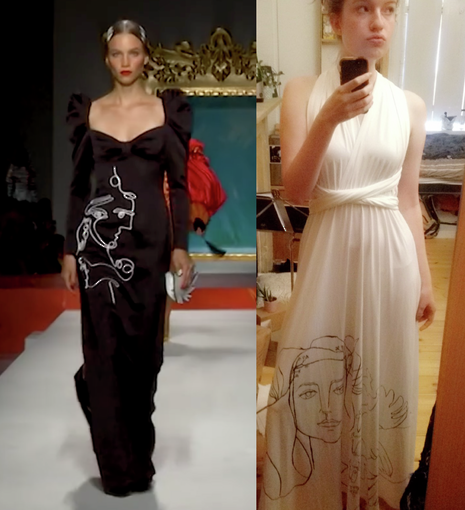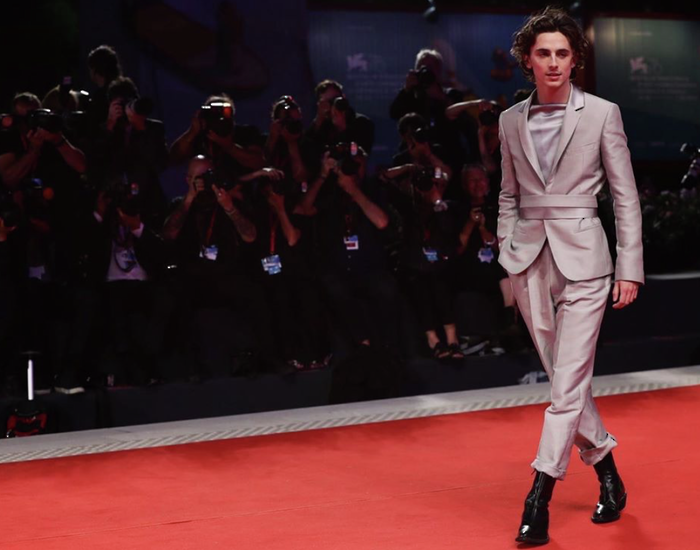Moschino’s homage to Pablo: An Alternate Picasso Universe
Marie-Louise James wonders whether Jeremy Scott’s Picasso-inspired collection for Moschino really lived up to the legacy of the prolific artist, or whether it failed to encompass what makes Picasso unique
I have always loved the idea of Picasso in fashion. Last year, I took matters into my own hands when I decided to paint a $15 bridesmaid gown using his simple one-line drawings as inspiration. The dress was my take on black tie May Ball attire.
This is not to compare myself to famed designer Jeremy Scott in any way. Yet when I heard about his Spring/Summer 2020 collection for Moschino, showcased at Milan Fashion Week, I was excited. The time had come, finally, for a major fashion house to embody Picasso in its own sartorial way.

Scott could have done – and I doubt many people have said this regarding the self-proclaimed “King of Camp” – more.
Some of the looks on the runway were the kind of characters you might see walking around in an alternate Picasso universe: colorful matadors, polka-dotted flamenco dancers, or a harlequin-musician played by Bella Hadid. Many of the garments, however, seemed to confine themselves to being literal with a capital L. For example, one of Picasso’s female portraits was plastered onto a dress. A Picasso hand became a bag. Patterns from his still-life paintings turned into whole fabrics and prints, appearing on boleros, trousers, and dresses. Black gloves daintily held music scores and leathery cubist guitars. One model emerged from a monochrome canvas.
The more wearable ready-to-wear items represented a delightfully pared down version of Moschino’s take on Picasso. In a subtler nod, minimal imagery met conventional silhouettes with a puffy-sleeved little black dress and jumpsuit. If you’re going to go for Picasso, either go all the way or choose the latter nuanced road. These few pieces will inevitably become the collection’s wearable, street-style takeaway.
Many critics have praised Jeremy Scott for bravely attempting to go “there.” To use the Pablo Picasso in another art form. Yet, where were the dizzying overlapping planes, or sculptural collages? Where was the abandoned perspective, one half frontal and the other in profile? Instead of reusing prints or playing into a Picasso cosplay, the collection could have experimented with the rules Picasso broke – the shapes, the three-dimensional constructions, the visual distortion.
Scott himself acknowledged this element of Picasso’s work, even if he could have developed the idea further. “That’s what I tried to take from Picasso – his, like, abandonment from reality,” Scott said in a Vogue behind-the-scenes video. “Someone’s face could have an eye up here and a mouth over there. So I thought: why not a shoulder that’s up here and then one’s that out there, and change the angles and kind of push the boundaries and push myself?” But when I think of sculptural, turning a one-piece into an entire guitar feels like a cop-out. A few of the garments, though, were closer to Picasso’s spirit: jutting sleeves atop flared out skirts, or a green top with painted breasts in diverging angles. It is in these pieces that Scott proves just how productive and vibrant the combination of art and fashion can be.
Aesthetics aside, neither Picasso’s work nor his artistic presence were ever just visual “gags”. Although, fashion shouldn’t take itself too seriously it should be aware of when a piece is insensitive. This was evident in the use of certain details of Guernica in the collection, an inclusion that seemed blatantly thoughtless given the painting’s symbolism and portrayal of the tragedies of war. With an artist so prolific – having created over 20,000 works of art during his life – surely works from the artist’s other years would have made for more socially-conscious material.
Moschino’s brand identity aside: if a designer were to adapt Picasso again in the future, could the voyeuristic element of “Picasso’s woman” also be addressed? Picasso always described himself as a painter of women: “Like any artist, I am primarily the painter of woman,” he once said, “and, for me, woman is essentially a machine for suffering.” I remember first reading these words on the walls of the Reina Sofia Museum in Madrid as an 18-year-old. I cannot help but hear them when I see his work – despite my admiration for his genius. Seeing the many models strut in Picasso-inspired ready-to-wear under bright lights and flashing iPhones made me wonder if, in some ways, it would have been better to reclaim explicitly this aspect of the artist’s narrative, shifting its voyeurism into a reclamation of the female narrative.
 News / Uni Scout and Guide Club affirms trans inclusion 12 December 2025
News / Uni Scout and Guide Club affirms trans inclusion 12 December 2025 News / Pembroke to convert listed office building into accom9 December 2025
News / Pembroke to convert listed office building into accom9 December 2025 News / Cambridge Vet School gets lifeline year to stay accredited28 November 2025
News / Cambridge Vet School gets lifeline year to stay accredited28 November 2025 Features / Searching for community in queer Cambridge10 December 2025
Features / Searching for community in queer Cambridge10 December 2025 News / Uni redundancy consultation ‘falls short of legal duties’, unions say6 December 2025
News / Uni redundancy consultation ‘falls short of legal duties’, unions say6 December 2025










